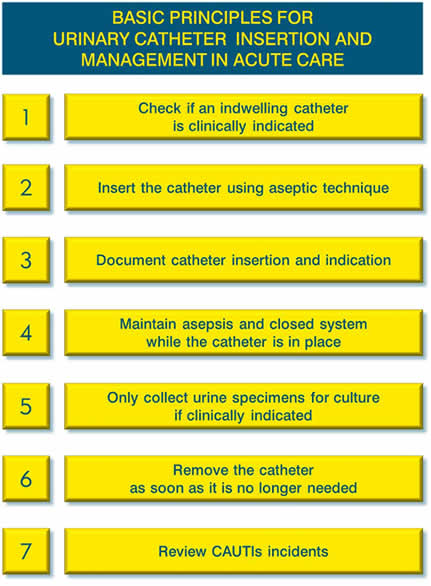Urinary catheterisation is a common clinical procedure. While there are some benefits of catheters, there is a risk that a patient may get a urinary tract infection because of the device.
Catheter associated urinary tract infections (CAUTIs) have a significant burden on the health system. Those affected by a CAUTI are likely to have a hospital stay that is at least twice as long1,2, and costs twice as much3 than those without a CAUTI. A patient with a CAUTI is also more likely to acquire drug-resistant infections which may need treatment with more complex antimicrobial therapy4.

CAUTI Improvement Project
The CAUTI Improvement Project was launched in 2016 to help health workers in reducing the number of CAUTIs in acute care settings. It is based on the basic principles for catheter insertion and management (see above) and provides decision support tools, clinician education, patient information, investigation tools, and promotional materials to promote better clinical practices.
The resources also help health facilities meet the requirements of the NSW Health Guidelines - Insertion and Management of Urethral Catheters for Adult Patients (GL2021_015) as well as the National Safety and Quality Health Service (NSQHS) Standards, particularly:
Criterion 3.8:
Developing and implementing a system for use and management of invasive devices based on the current national guidelines for preventing and controlling infections in health care
Criterion 3.9:
Implementing protocols for invasive device procedures regularly performed within the organisation.
References
- Loveday, H.P., et al., epic3: National evidence-based guidelines for preventing healthcare-associated infections in NHS hospitals in England. Journal of Hospital Infection, 2014. 86(1): p. s1-s7
- Daniels, K.R., G.C. Lee, and C.R. Frei, Trends in catheter-associated urinary tract infections among a national cohort of hospitalized adults, 2001-2010. American Journal of Infection Control, 2014. 42: p. 17-22.
- Jackson, T.J., et al., Marginal costs of hospital acquired conditions: information for priority setting for patient safety programs and research. Journal of Health Services Research and Policy, 2011. 16(3): p. 141-146.
- Chenoweth, C.E., C.V. Gould, and S. Saint, Diagnosis, management, and prevention of catheter-associated urinary tract infections. Infect Dis Clin N Am, 2014. 28(1): p. 105-119.

